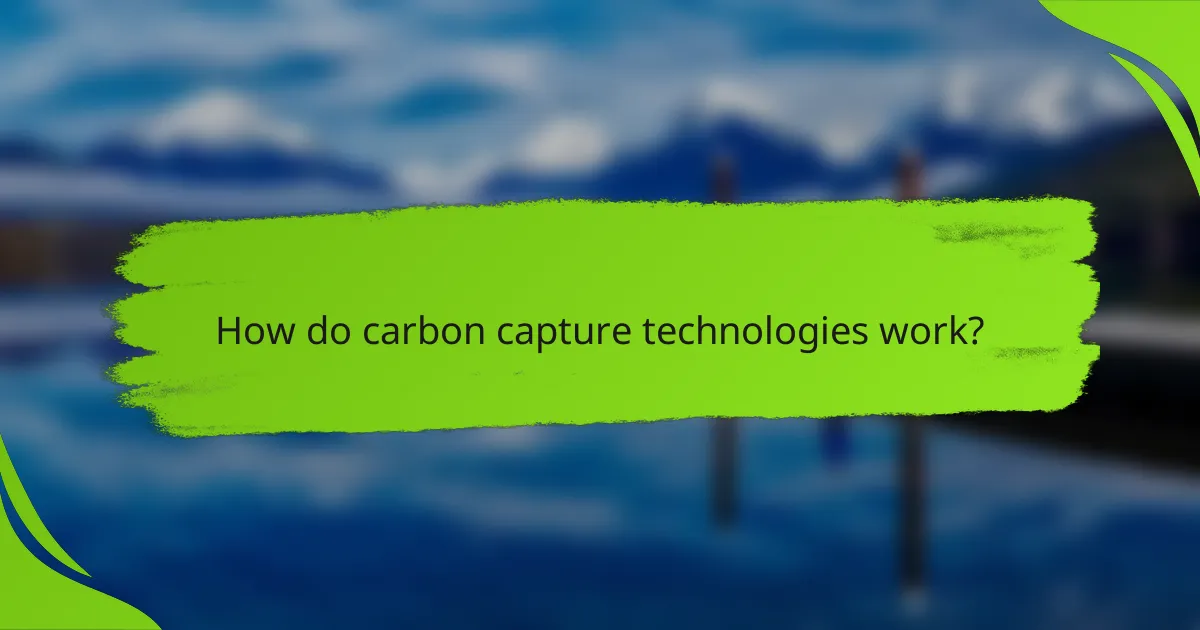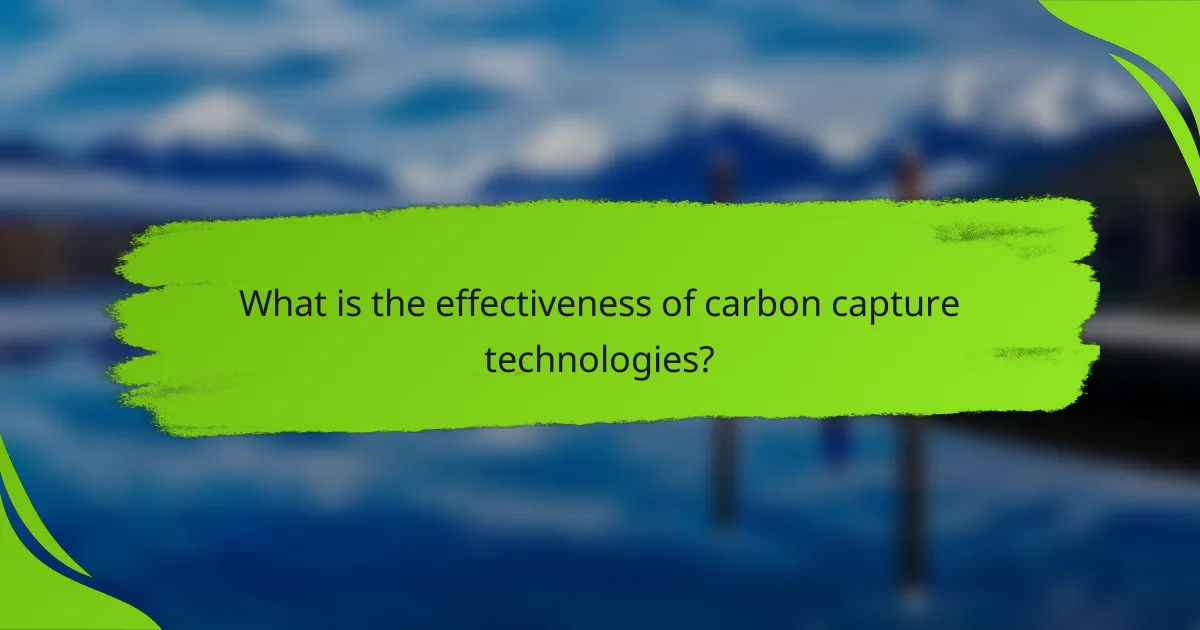Carbon capture technologies play a pivotal role in mitigating climate change by capturing carbon dioxide emissions from industrial processes and the atmosphere. These methods, which vary in their mechanisms and effectiveness, are essential for reducing greenhouse gas emissions and can be adapted for various applications. As the world seeks sustainable solutions, the future potential of these technologies remains a key focus in the fight against global warming.

What are the most effective carbon capture technologies?
The most effective carbon capture technologies include methods that directly remove carbon dioxide from the atmosphere or capture it from industrial processes. These technologies vary in their mechanisms, effectiveness, and potential for scalability, making them crucial in the fight against climate change.
Direct Air Capture
Direct Air Capture (DAC) involves using chemical processes to extract carbon dioxide directly from ambient air. This technology typically employs large fans to draw air through a filter that captures CO2, which can then be stored underground or utilized in various applications.
While DAC has significant potential, its effectiveness is influenced by energy requirements and costs, which can range from hundreds to several hundred dollars per ton of CO2 captured. The scalability of DAC is promising, particularly in regions with abundant renewable energy sources.
Carbon Capture and Storage
Carbon Capture and Storage (CCS) focuses on capturing carbon dioxide emissions from industrial sources, such as power plants, before they enter the atmosphere. The captured CO2 is then transported and stored in geological formations, preventing its release.
CCS can reduce emissions by up to 90% in certain applications, but it requires substantial investment in infrastructure and monitoring to ensure safe storage. Regulations and incentives often play a critical role in the deployment of CCS technologies.
Bioenergy with Carbon Capture and Storage
Bioenergy with Carbon Capture and Storage (BECCS) combines biomass energy production with carbon capture technology. This process captures the CO2 emitted during biomass combustion and stores it, resulting in negative emissions if managed correctly.
BECCS has the potential to be a significant tool for achieving net-zero emissions, but it requires careful management of land use and resource allocation to prevent competition with food production. The cost-effectiveness of BECCS can vary based on local biomass availability and energy prices.
Mineralization
Mineralization involves converting CO2 into stable minerals through natural or engineered processes. This method can occur in various geological formations where CO2 reacts with minerals to form carbonates, effectively locking away the carbon for millennia.
While mineralization is a promising long-term solution, it is currently limited by the speed of natural processes and the availability of suitable minerals. Ongoing research aims to enhance the efficiency and scalability of this technology.
Ocean-Based Carbon Capture
Ocean-based carbon capture leverages the ocean’s natural ability to absorb CO2. Techniques include enhancing ocean alkalinity or cultivating seaweed, which absorbs carbon during growth and can be harvested for various uses.
This method has the potential to sequester large amounts of carbon, but it faces challenges related to ecological impacts and regulatory frameworks. Effective management and monitoring are essential to ensure that ocean-based solutions do not disrupt marine ecosystems.

How do carbon capture technologies work?
Carbon capture technologies work by capturing carbon dioxide (CO2) emissions from sources like power plants and industrial processes before they enter the atmosphere. These methods aim to reduce greenhouse gas emissions and combat climate change by either storing the captured CO2 or reusing it in various applications.
Absorption Process
The absorption process involves dissolving CO2 in a liquid solvent, typically amines, which chemically react with the gas. This method is widely used in industrial applications due to its effectiveness in capturing high concentrations of CO2.
After absorption, the solvent is heated to release the captured CO2, allowing for its storage or utilization. While effective, this process can be energy-intensive, requiring significant heat input, which can impact overall efficiency.
Adsorption Process
In the adsorption process, CO2 molecules adhere to the surface of solid materials, known as adsorbents, such as zeolites or activated carbon. This method is advantageous for its simplicity and lower energy requirements compared to absorption.
Adsorption can be performed at lower temperatures, making it suitable for various applications. However, the capacity of adsorbents can be limited, and they may require regeneration, which involves releasing the captured CO2 and reactivating the adsorbent.
Membrane Separation
Membrane separation utilizes selective barriers to separate CO2 from other gases based on size or chemical affinity. This technology is gaining traction due to its potential for lower energy consumption and smaller footprint compared to traditional methods.
Membrane systems can be designed for specific applications, such as natural gas processing or post-combustion capture. However, challenges include membrane fouling and the need for high-pressure operation, which can complicate implementation.
Cryogenic Separation
Cryogenic separation involves cooling gas mixtures to very low temperatures, causing CO2 to liquefy and separate from other gases. This method is particularly effective for high-purity CO2 capture and is often used in industrial processes.
While cryogenic techniques can achieve high capture rates, they require substantial energy for cooling and can be costly to operate. This method is best suited for applications where high purity is essential, such as in food and beverage industries or enhanced oil recovery.

What is the effectiveness of carbon capture technologies?
Carbon capture technologies can significantly reduce greenhouse gas emissions by capturing carbon dioxide (CO2) from various sources before it enters the atmosphere. Their effectiveness varies based on the method used, the scale of implementation, and the specific application.
Capture Efficiency Rates
Capture efficiency rates refer to the percentage of CO2 that a technology can successfully extract from emissions. Most advanced carbon capture systems achieve efficiencies ranging from 60% to over 90%, depending on the technology and the source of emissions. For instance, post-combustion capture on coal-fired power plants typically operates at around 85% efficiency.
Factors affecting capture efficiency include the concentration of CO2 in the flue gas and the specific technology employed. Technologies like direct air capture may have lower efficiency rates due to the dilute nature of atmospheric CO2, often capturing around 10% to 30% of CO2 in the air.
Cost-Effectiveness Analysis
The cost-effectiveness of carbon capture technologies is a critical consideration for widespread adoption. Costs can vary widely, with estimates ranging from $50 to $100 per ton of CO2 captured, depending on the method and scale. Factors influencing these costs include capital investment, operational expenses, and the availability of incentives or subsidies.
For example, large-scale industrial applications may benefit from economies of scale, reducing the cost per ton captured. In contrast, smaller projects or those using newer technologies may face higher costs until they achieve wider deployment and technological maturity.
Environmental Impact
The environmental impact of carbon capture technologies is generally positive, as they help mitigate climate change by reducing CO2 emissions. However, the overall effectiveness depends on how captured CO2 is managed. If stored underground or utilized in products, the environmental benefits are maximized.
Conversely, if captured CO2 is not properly managed or if the energy used for capture comes from fossil fuels, the net benefits may be diminished. It’s crucial to assess the entire lifecycle of carbon capture technologies to ensure they contribute positively to environmental goals.

What are the challenges facing carbon capture technologies in Canada?
Carbon capture technologies in Canada face several significant challenges that hinder their widespread adoption and effectiveness. Key issues include regulatory hurdles, infrastructure limitations, and public perception problems that must be addressed to advance these technologies.
Regulatory Hurdles
In Canada, the regulatory environment for carbon capture technologies is complex and often inconsistent across provinces. Different jurisdictions may have varying standards and incentives, which can create confusion and slow down project approvals. Streamlining regulations and providing clear guidelines could facilitate faster implementation.
Moreover, existing environmental regulations may not fully account for the unique aspects of carbon capture, leading to additional compliance costs and delays. Policymakers need to establish supportive frameworks that encourage investment while ensuring environmental protection.
Infrastructure Limitations
Infrastructure limitations pose a significant challenge for carbon capture technologies in Canada. The country lacks a comprehensive network for transporting captured carbon dioxide, which is essential for effective utilization or storage. Developing pipelines and storage facilities requires substantial investment and long-term planning.
Additionally, existing industrial facilities may not be equipped to integrate carbon capture systems, necessitating upgrades or retrofitting. This can increase costs and extend project timelines, making it crucial for stakeholders to collaborate on infrastructure development.
Public Perception Issues
Public perception of carbon capture technologies in Canada can be a barrier to their acceptance and implementation. Many individuals may not fully understand the benefits or mechanics of these technologies, leading to skepticism and opposition. Education and outreach efforts are essential to inform the public about the role of carbon capture in combating climate change.
Furthermore, concerns about the safety and efficacy of carbon storage methods can contribute to resistance. Engaging communities in discussions and addressing their concerns transparently can help build trust and support for carbon capture initiatives.

What are the future potentials of carbon capture technologies?
The future potentials of carbon capture technologies lie in their ability to significantly reduce greenhouse gas emissions and mitigate climate change. As advancements continue, these technologies may become more efficient and cost-effective, making them essential in global efforts to achieve net-zero emissions.
Innovations in Technology
Recent innovations in carbon capture technologies include advancements in direct air capture (DAC) and bioenergy with carbon capture and storage (BECCS). DAC systems can extract CO2 directly from the atmosphere, while BECCS combines biomass energy production with carbon capture, effectively removing CO2 during energy generation.
Emerging materials, such as metal-organic frameworks (MOFs) and new solvents, are enhancing the efficiency of CO2 absorption. These innovations aim to lower operational costs and increase the scalability of carbon capture systems, making them more viable for widespread use.
Investment Trends
Investment in carbon capture technologies is on the rise, driven by both private and public sectors. Governments worldwide are allocating billions of dollars to support research and development, while private companies are increasingly funding pilot projects to demonstrate feasibility and effectiveness.
In the United States, the Inflation Reduction Act has incentivized investments in carbon capture through tax credits, encouraging companies to develop and deploy these technologies. This trend is expected to continue, with projections indicating that global investments could reach hundreds of billions of dollars in the coming years.
Policy Support and Incentives
Policy support is crucial for the advancement of carbon capture technologies. Many countries are implementing regulations and incentives to promote the adoption of these systems, recognizing their role in achieving climate targets. For instance, the European Union has set ambitious goals for carbon neutrality by 2050, which includes significant investments in carbon capture initiatives.
In addition to tax credits, governments are offering grants and subsidies to encourage research and commercialization of carbon capture technologies. Companies looking to invest in these technologies should stay informed about local policies and incentives that can enhance their financial viability.
